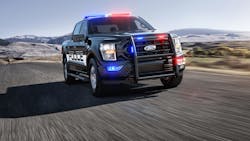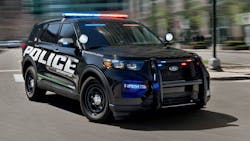Patrol vehicles and the equipment within them have evolved over the past 60 years, and even more in the past 10 years. From unmarked, single emergency light sedans, to integrated portable offices, the patrol vehicle is perhaps the most used tool any officer has or is issued. Unless assigned to foot patrol, bike patrol or a mounted unit, most of an officer’s day is spent inside their patrol vehicle.
The Officer.com webinar Trends & Emerging Technologies in Law Enforcement Vehicles (officer.com/21243160), sponsored by Leonardo, takes a look at the evolution of law enforcement vehicles and accessories. Moderated by Officer Media Group Editorial Director Frank Borelli, the webinar includes several interviews conducted by Editor Paul Peluso with Leonardo Vice President of Marketing and Communications Nathan Maloney; Ford Pro Police Brand Marketing Manager Greg Ebel; and Setina Manufacturing Company Vice President Judy Setina and Director of Sales and Marketing Brett Ware.Patrol vehicles
In the early 1900s, police vehicles were viewed as a budget-saving tool. One officer in a patrol vehicle could cover as much area as several officers on foot. Markings on those early vehicles were simple and usually consisted of the word “Sheriff” or an image such as a star or badge. The first police package vehicle wasn’t released until after World War 1. Ford, Chevrolet and Dodge all released their own police package vehicles in the 1950s. The NYPD was the first department with a fleet of “radio motor patrol vehicles.”
Technological advancements in patrol vehicle accessories such as Automated License Plate Readers and the LoJack vehicle location system came about in the 1970s. In the 1980s, more computer chips were put into patrol vehicles and emergency lighting evolved from single or double “bubbles” to streamlined, multi-light, multifunction units. By the early 1990s, laptop computers—called Mobile Data Terminals—were finding their way into patrol vehicles.
Prior to the 2000s, in-vehicle dashboard-mounted cameras were becoming commonplace. From 2000 to 2010, body-worn cameras were developed and adopted by law enforcement agencies across the country. Emergency lighting continued to develop as LED-driven lighting evolved. The use of laptops in vehicles continued to gain popularity as software and connectivity evolved. The early integration of multiple systems inside the vehicle was also gaining steam.
Since 2010, there has been a continued evolution of software leading to the digitization of papers, the streamlining of dispatch-related information transfer and the integration of systems and data sharing across platforms.
For Ford, the Crown Victora was centerpiece of their law enforcement offering for much of the ‘80s and ‘90s. “It’s interesting. At tradeshows we still get asked, ‘When is the Crown Vic coming back,’ ” says Ebel. “But as we evolved over time, we had the Police Interceptor sedan and then with the Utility—V6, all-wheel drive—that changed the game. There was more performance, better fuel economy. It’s just a better overall package. What we’re seeing now from that evolution is that the industry as a whole has been going to SUVs. Our Police Interceptor Utility is our bread and butter.”
Ebel says that another step forward in the evolution for Ford is the standard hybrid model of the Police Interceptor Utility. “Why it works so well for law enforcement is because of just the natural duty cycle and the excessive idle times. With the hybrid, the engine is off for a very large chunk. 80% of the idle time, the engine is off.”
Ford also has focused on the F-150 Police Responder, which was all-new for 2021 and is the only pursuit-rated pickup truck on the market. “Some agencies need to have that performance and capability both on and off road. That’s what the F-150 Police Responder delivers,” he says.
The automotive industry as a whole is seeing a shift from internal combustion engines to all-electric engines. While law enforcement will naturally lag behind in adoption of the new technology due to the requirements for patrol vehicles, Ford is working to make it a reality. This past fall, the Mustang Mach-E police pilot was part of the Michigan State Police 2022 model year police vehicle evaluation program. “We wanted to demonstrate to our customers that an all-electric vehicle can in fact deliver within the law enforcement duty cycle and I think that’s what it did,” says Ebel.Contemporary equipment
Patrol vehicles serve three primary purposes: Transportation, Equipment and Prisoner Transport. The vehicles are often modified with prisoner barriers, transport “cages,” rugged seats, vinyl floor coverings and spit shields. They also often serve as a hub for traffic safety/enforcement equipment. This includes pit bumpers, RADAR, flares, collapsible cones, traffic wands, safety vests and stop sticks.
Setina Manufacturing Company founder John Setina started out with the Washington State Patrol working on vehicles and was asked to create rollbars for the training vehicles at the academy. During that time, John recognized the need for a prisoner transport partition. In the back of his garage, he worked on his products until he was able to get the patent. Two years later, he quit the patrol. “Washington State Patrol today is still one of our best customers and our biggest supporters,” says Judy Setina.
The same forces that have driven the evolution of patrol vehicles also have affected accessories as well, according to Ware. “The recipe for a police car years ago was a big heavy car, heavy-duty—big engine, big breaks. Same with the accessories. Something such as a cargo box, just up until recently, we would want a box that was very heavy-duty and weight wasn’t so much of a concern. As things have evolved, we have become smarter about our use of materials.” Now, Ware says that accessories are constructed out of smart materials, where the skeleton is strengthened, but other areas are lightened up. The cargo box, has a steel skeleton, but the cargo sections are made from aluminum. The same is done with push bumpers, where both steel and aluminum are used.
Another advance Ware touted is the SmartBelt system. “When you plug in the Smartbelt, when you buckle in that suspect, it actually locks the seat belt, so it puts it into an emergency behavior so that it keeps it nice and tight. They’re not squirming around back there.” The system includes an output that can speak to the siren controller and support different behaviors to alert an officer. If an officer arrests one suspect, and is talking to another, if that person was to get out of the belt, that officer would be alerted.Scanning the environment
Automatic License Plate Recognition (ALPR) systems have evolved to include date integration and sharing. Contemporary ALPR systems can alert the officer to Amber and Silver alert related hits, license plates related to high-risk events, suspended/expired/revoked registration and open warrants/BOLOs for a vehicle’s registered owner.
“The license plate readers have come down in size and their efficiency has been amplified through technologies due to the optics and the lighting that is used in them,” says Maloney, noting that when ALPR was first developed, the cameras were the size of a bread box. Now the units have shrunk down to about 5 inches by 5 inches in size.
“Not only do we provide a smaller product, but we provide a product that’s more useful to law enforcement. The optics, the lenses, things inside the camera that you wouldn’t normally see have improved because of a variety of uses for those optics. One of the biggest things is the ability to have different focal lengths in the camera. If you are doing an interdiction mission, you can sit on the side of the road, given the right focal length, and be able to capture two or three lanes of traffic, so that’s a big improvement.”
Another thing Leonardo has heard from its customers is that trunk space is at a premium. “They don’t want a big processor box in the trunk. We’ve worked hard to scale down the size of the processor box, so it takes up less space.”
A lot of the advancements Leonardo is working on involves the back-office system. In the operations center, Leonardo is putting more analytical tools in for officers to be able to do things like cross-reference searches. This includes convoy analysis. There’s one case Maloney recalled in which two vehicles passed each other at the same time every week and it was determined to be a pass-off of money and drugs in moving traffic. One of the company’s goals remains how to make the LPR system a robust tool. Not just looking at license plates and making them a data source, but also including other points of information.






